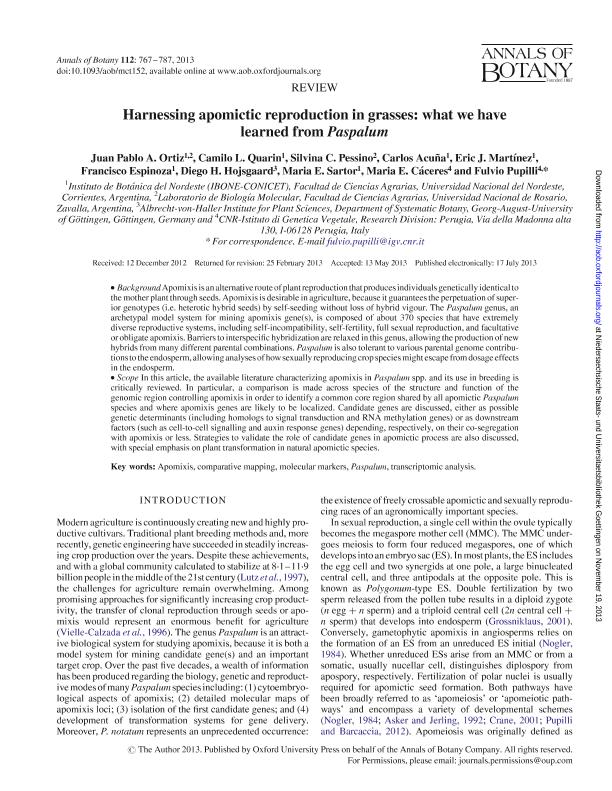Mostrar el registro sencillo del ítem
dc.contributor.author
Ortiz, Juan Pablo Amelio

dc.contributor.author
Quarin, Camilo Luis

dc.contributor.author
Pessino, Silvina Claudia

dc.contributor.author
Acuña, Carlos Alberto

dc.contributor.author
Martínez, Eric Javier

dc.contributor.author
Espinoza, Francisco

dc.contributor.author
Hojsgaard, Diego Hernan
dc.contributor.author
Sartor, Maria Esperanza

dc.contributor.author
Cáceres, María Emilia
dc.contributor.author
Pupilli, Fulvio
dc.date.available
2015-09-29T21:30:18Z
dc.date.issued
2013-07-17
dc.identifier.citation
Ortiz, Juan Pablo Amelio; Quarin, Camilo Luis; Pessino, Silvina Claudia; Acuña, Carlos Alberto; Martínez, Eric Javier; et al.; Harnessing apomictic reproduction in grasses : what we have learnt from Paspalum; Oxford University Press; Annals Of Botany; 112; 5; 17-7-2013; 767-787
dc.identifier.issn
0305-7364
dc.identifier.uri
http://hdl.handle.net/11336/2192
dc.description.abstract
Background Apomixis is an alternative route of plant reproduction that produces individuals genetically identical to the mother plant through seeds. Apomixis is desirable in agriculture, because it guarantees the perpetuation of superior genotypes (i.e. heterotic hybrid seeds) by self-seeding without loss of hybrid vigour. The Paspalum genus, an archetypal model system for mining apomixis gene(s), is composed of about 370 species that have extremely diverse reproductive systems, including self-incompatibility, self-fertility, full sexual reproduction, and facultative or obligate apomixis. Barriers to interspecific hybridization are relaxed in this genus, allowing the production of new hybrids from many different parental combinations. Paspalum is also tolerant to various parental genome contributionsto the endosperm, allowing analyses of how sexually reproducing crop species might escape from dosage effects in the endosperm. Scope In this article, the available literature characterizing apomixis in Paspalum spp. and its use in breeding is critically reviewed. In particular, a comparison is made across species of the structure and function of the genomic region controlling apomixis in order to identify a common core region shared by all apomictic Paspalum species and where apomixis genes are likely to be localized. Candidate genes are discussed, either as possible genetic determinants (including homologs to signal transduction and RNA methylation genes) or as downstream factors (such as cell-to-cell signalling and auxin response genes) depending, respectively, on their co-segregation with apomixis or less. Strategies to validate the role of candidate genes in apomictic process are also discussed, with special emphasis on plant transformation in natural apomictic species.
dc.format
application/pdf
dc.language.iso
eng
dc.publisher
Oxford University Press

dc.rights
info:eu-repo/semantics/openAccess
dc.rights.uri
https://creativecommons.org/licenses/by-nc-sa/2.5/ar/
dc.subject
Apomixis
dc.subject
Comparative Mapping
dc.subject
Molecular Markers
dc.subject
Paspalum
dc.subject
Transcriptomic Analysis
dc.subject.classification
Biología Reproductiva

dc.subject.classification
Ciencias Biológicas

dc.subject.classification
CIENCIAS NATURALES Y EXACTAS

dc.title
Harnessing apomictic reproduction in grasses : what we have learnt from Paspalum
dc.type
info:eu-repo/semantics/article
dc.type
info:ar-repo/semantics/artículo
dc.type
info:eu-repo/semantics/publishedVersion
dc.date.updated
2016-03-30 10:35:44.97925-03
dc.journal.volume
112
dc.journal.number
5
dc.journal.pagination
767-787
dc.journal.pais
Reino Unido

dc.journal.ciudad
Oxford
dc.description.fil
Fil: Ortiz, Juan Pablo Amelio. Consejo Nacional de Investigaciones Científicas y Técnicas. Centro Científico Tecnológico Nordeste. Instituto de Botánica del Nordeste (i); Argentina. Universidad Nacional de Rosario. Facultad de Cs.agrarias. Laboratorio de Biologia Molecular; Argentina
dc.description.fil
Fil: Quarin, Camilo Luis. Consejo Nacional de Investigaciones Científicas y Técnicas. Centro Científico Tecnológico Nordeste. Instituto de Botánica del Nordeste (i); Argentina
dc.description.fil
Fil: Pessino, Silvina Claudia. Consejo Nacional de Investigaciones Científicas y Técnicas. Centro Científico Tecnológico Nordeste. Instituto de Botánica del Nordeste (i); Argentina. Universidad Nacional de Rosario. Facultad de Cs.agrarias. Laboratorio de Biologia Molecular; Argentina
dc.description.fil
Fil: Acuña, Carlos Alberto. Consejo Nacional de Investigaciones Científicas y Técnicas. Centro Científico Tecnológico Nordeste. Instituto de Botánica del Nordeste (i); Argentina
dc.description.fil
Fil: Martínez, Eric Javier. Consejo Nacional de Investigaciones Científicas y Técnicas. Centro Científico Tecnológico Nordeste. Instituto de Botánica del Nordeste (i); Argentina
dc.description.fil
Fil: Espinoza, Francisco. Consejo Nacional de Investigaciones Científicas y Técnicas. Centro Científico Tecnológico Nordeste. Instituto de Botánica del Nordeste (i); Argentina
dc.description.fil
Fil: Hojsgaard, Diego Hernan. Universitat Of Gottingen; Alemania; . Consejo Nacional de Investigaciones Científicas y Técnicas. Centro Científico Tecnológico Nordeste. Instituto de Botánica del Nordeste (i); Argentina
dc.description.fil
Fil: Sartor, Maria Esperanza. Consejo Nacional de Investigaciones Científicas y Técnicas. Centro Científico Tecnológico Nordeste. Instituto de Botánica del Nordeste (i); Argentina
dc.description.fil
Fil: Cáceres, María Emilia. Consejo Nacional de Investigaciones Científicas y Técnicas. Centro Científico Tecnológico - CONICET - Tandil. Centro de Investigación Veterinaria de Tandil; Argentina. Consiglio Nazionale Delle Ricerche; Italia;
dc.description.fil
Fil: Pupilli, Fulvio. Consiglio Nazionale Delle Ricerche; Italia;
dc.journal.title
Annals Of Botany

dc.relation.alternativeid
info:eu-repo/semantics/altIdentifier/doi/http://dx.doi.org/10.1093/aob/mct152
dc.relation.alternativeid
info:eu-repo/semantics/altIdentifier/url/http://aob.oxfordjournals.org/content/112/5/767
Archivos asociados
